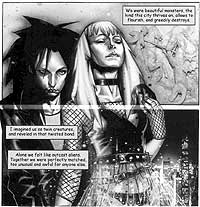
|
"Amy and Jordan" (Pantheon; 288 pages; $21) collects Mark Beyer's comic strip that ran in a select few alternative weekly newspapers during the early 90s. A tour de force of the form, it combines wild, fever-dream visions with dark, existentialist gag humor. Beyer takes all the clichs of the traditional "laugh-a-day" strip and turns them inside out. The typically cute, bourgeois family of the dailies has been replaced by Amy and Jordan, a fear-filled, childless couple who live in a nameless city full of bugs, aliens, dirt and neighbors like Dame Head, who is just a head on a platter. Their Dadaist adventures include having their apartment building dragged out of town by the vermin who live with them. "They couldn't stand the city. But why did they have to drag us out here and leave us," wonders Amy, in a typically Beyerian "punch line." Other strips read like Sartre doing "The Lockhorns." In one typical example, the objects in their apartment simply begin fading away, including Jordan. "I'm fading into oblivion," he tells Amy, "just a bad memory that you will soon forget." The transcendent ingenuity of "A+J" combines laughable cartoonish miseries with sometimes-profound metaphors for such subjects as the transience of objects and memory.
 TIGHT LIVING: A + J in a typical strip
TIGHT LIVING: A + J in a typical strip |
But the disturbingly funny profundities of "Amy and Jordon" may not even be the best reason for reading it. Beyer's strip was the most visually inventive since the turn-of-the-century height of newspaper cartoonists like Winsor McCay and Lyonel Feininger. Drawing in a black and white style that could well be classified as Art Brut, it defies any preconceptions of what a comic strip should look like. Beyer stuffs his raw caricatures into the corners of zany layouts, no two of which are alike. And a good thing, too. It would be unreadable otherwise. Even smart strip collections like the "Complete Peanuts" suffer from the monotony of the square panels and the tedious pace of setupdevelopmentpunch line. Printed with just one, enlarged strip per page, the A+J collection not only avoids this pitfall, but leaps over it. The bleak negativity of the message has its counterpoint in the constant variety of the form. The two combined make Mark Beyer's "Amy and Jordan" a beautiful visual poem to the miseries of modern urban life.

|
"How Loathsome" (NBM; 110 pages; $13.95), written by Ted Naifeh and Tristan Crane and illustrated by Naifeh, also chronicles the tawdry poetry of modern urban life, but it in the form a graphic novel. At the same time it happens to be one of the most interesting gay-themed comix to come around in a long while. Set in San Francisco's trans-gendered, drug addict underground, its smart writing and stylish graphics move fluidly between grit and transcendence. Divided into four short stories rather than a single narrative, each chapter features Catherine Gore, a lanky, androgynous lesbian with a drug habit and a talent for observation and story telling. The first chapter typifies the book's consistently refreshing unconventionality. The story details Catherine's brief but obsessive love affair with Chloe, a beautiful, blonde male to female transsexual. They bond over a mutual disillusionment with their peers — lesbians involved in "unbelievably dull left-wing political activities" and the gay male "trend towards gym-cloned pretty boys." The characters of "How Loathsome" are the marginalized of the marginal. Consequently, Catherine and Chloe's relationship ends for one simple yet complex reason. "I'm not a lesbian," Chloe says.
 Catherine and Chloe hit the town in "How Loathsome"
Catherine and Chloe hit the town in "How Loathsome" |
Other chapters show Catherine joined by her friends Nick, the defensively macho user/dealer, and Alex, the cute junkie rent boy, as they shoot up, go to clubs and wrestle with the complications of a world where truth blends with fiction and fantasy with reality. At one point Alex flirts with a boy who turns out to be a girl but who says she isn't. Who knows the truth? But in the end, suggest the book, does it matter? Even the illustrations by Ted Naifeh, using an unusual palette of black, gray and bronze, strike a harmonic discord between the gay fetishising of beautiful bodies and costumes with the straight pulp illustration of people shooting up and fooling around. Defying the conventions of "positive" gay literature for something much less correct and therefore more interesting, "How Loathsome" echoes the drug-influenced, hallucinatory work of William S. Burroughs. Both Burroughs and Crane and Naifeh give readers of any sexual variety the excitement of grungy, x-rated kicks while leaving them to ponder larger things like the nature of sexual attraction and self-identity. The book ends in a back alley as Catherine and her drag queen pals snort coke. In an epiphany she concludes, "There is only finding joy where you can, with whom you can," a line to live by no matter where you hang your hat.
